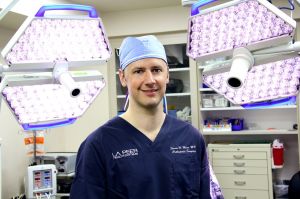Osteoarthritis
By Steven Meier
Osteoarthritis (OA), also known as age-related arthritis or degenerative joint disease, is a condition in which joint cartilage becomes inflamed and wears down over time. Osteoarthritis, which takes the form of arthritis in the knee, hip, shoulder or other joint, is the most common joint disorder, and several different forms of arthritis exist. Unfortunately, there is currently no cure for osteoarthritis. Treatment in Los Angeles is usually oriented toward alleviating pain and stiffness to improve a patient’s quality of life.
 Osteoarthritis, also known as degenerative joint disease, refers to the damage and wearing down of articular cartilage. It can often be accompanied by overgrowth of bone, narrowing of joint space, deformity of the affected joints, and some hardening of the bone at the joint surface. Treatment of osteoarthritis in Los Angeles varies depending on the severity of the disease and the symptoms experienced.
Osteoarthritis, also known as degenerative joint disease, refers to the damage and wearing down of articular cartilage. It can often be accompanied by overgrowth of bone, narrowing of joint space, deformity of the affected joints, and some hardening of the bone at the joint surface. Treatment of osteoarthritis in Los Angeles varies depending on the severity of the disease and the symptoms experienced.
If you suffer from joint pain due to arthritis or degeneration over time, don’t hesitate to contact the Meier Orthopedic Sports and Regenerative Medicine in Los Angeles to learn more about your options for treatment or to schedule a consultation for orthopedic services and sports medicine. You can reach us at (310) 777-7845.
 Osteoarthritis can be common among:
Osteoarthritis can be common among:
- Older adults
- Overweight individuals
- Those with jobs requiring lots of movement/heavy lifting/stress on the joints
Many patients with osteoarthritis experience decreased mobility of the joints/decreased joint flexibility, as well as pain and swelling. The diminishing cartilage can often lead to painful bone spurs as the movements of the bone are not cushioned by sufficient cartilage between them, and may rub directly against each other, causing pain and overgrowth of bone in those areas.
Osteoarthritis Symptoms
Osteoarthritis symptoms typically develop slowly and get worse over time. Some of the most common osteoarthritis symptoms include:
- Pain in the joint during or following movement
- Tenderness in the joint when touched
- Stiffness in the joint, most often after inactivity
- Diminished flexibility, preventing the joint from achieving a full range of motion
- Bone spurs, or hard lumps of bone, forming around the joint
- Grating feeling or sound when the joint is moved
It is best to see a doctor for evaluation if you experience symptoms of arthritis that last for several weeks or more.
Causes of Osteoarthritis
The exact cause of osteoarthritis is unknown, but the mild presence of osteoarthritis here and there is considered a normal part of the aging process for everyone.
A variety of causes have been associated with osteoarthritis. Some of the most common include:
- Heredity
- Injury
- Overuse
- Age
When cases are more severe, this can be due to several factors, including genetic predisposition. Osteoarthritis may also be caused by wear and tear on a joint, or traumatic injury to that joint.
Risk Factors
- Osteoarthritis is genetic and can run in families.
- Obesity increases the risk of osteoarthritis in the hip, knee, ankle, and foot joints due to added stresses, and wear and tear.
- Bone fractures, torn cartilage, and ligament injuries can initiate the development of osteoarthritis later in life.
- Kneeling or squatting for more than an hour a day at work is a high-risk factor as well as occupations with a lot of lifting, stair climbing, or walking.
- Sports with direct impacts on joints (football), twisting (basketball or soccer), or throwing (baseball) increase the risk of developing osteoarthritis.
- Disorders that cause bleeding in the joint (hemophilia).
- Medical disorders that block a joint’s blood supply.
- Having other types of arthritis (chronic gout, pseudo gout, or rheumatoid arthritis).
OA Symptoms
Osteoarthritis symptoms typically develop slowly and get worse over time. Some of the most common osteoarthritis symptoms include:
- Pain in the joint during or following movement
- Tenderness in the joint when touched
- Stiffness in the joint, most often after inactivity
- Diminished flexibility, preventing the joint from achieving a full range of motion
- Bone spurs, or hard lumps of bone, forming around the joint
- Grating feeling or sound when the joint is moved
Symptoms of osteoarthritis begin to appear in a person’s middle age. Men are more likely to experience symptoms of osteoarthritis before the age of 55, but OA symptoms are more common in women after the age of 55. However, by the age of 70, almost everyone will have some symptoms somewhere in their bodies. Luckily, many people experience only minor symptoms. Some select people will not experience any symptoms, but X-rays can still show the presence of osteoarthritis even if there is no associated symptomology such as pain.
Read more about osteoarthritis from NIH.gov.
Diagnosis and Treatment
Diagnosis of osteoarthritis, or degenerative joint disease, is based on an assessment of the patient’s medical history as well as a physical examination and x-ray findings. While lab tests may not be able to diagnose arthritis by themselves, they may be ordered to rule out the possibility of other medical conditions that may be contributing to the development of arthritis.
There is no known cure for osteoarthritis, however, there are a number of treatments available to help ease the pain of join degeneration and maintain joint movement. These include:
- Health and behavior modification
- Medication
- Intra-articular treatments
- Surgery
At Meier Orthopedic Sports and Regenerative Medicine, we specialize in joint preservation surgery with the intent of reducing pain and improving joint mobility and overall function.
Learn more about osteoarthritis from WebMD.com.
Non-Surgical Treatment Options
 Osteoarthritis cannot be cured and will likely gradually worsen over time. Despite this, there exist many techniques that can increase mobility and reduce pain. Symptoms can be controllable. Surgery may be an option for some people, but other non-surgical treatments can also improve your quality of life by alleviating pain.
Osteoarthritis cannot be cured and will likely gradually worsen over time. Despite this, there exist many techniques that can increase mobility and reduce pain. Symptoms can be controllable. Surgery may be an option for some people, but other non-surgical treatments can also improve your quality of life by alleviating pain.
Over-the-counter (OTC) medications can be used to relieve the pain from osteoarthritis without a prescription. OTC drugs like acetaminophen (Tylenol), aspirin, ibuprofen (Advil), and naproxen are readily available to ease the pain of osteoarthritis.
Other medications for osteoarthritis pain can include:
- Vitamin/mineral supplementation such as glucosamine and chondroitin
- Capsaicin skin cream or topical warmers such as “IcyHot”
- Corticosteroid injections into the joint
- Artificial joint fluid injected into the knee joint
A doctor might also recommend making some lifestyle changes. By staying active and exercising regularly, patients can maintain joint mobility and flexibility. Patients should ask their doctor to recommend an exercise routine they can perform at home or in the water. Swimming and other water-based exercises can be especially helpful in that they put very little stress on the joints and encourage staying active.
A physician might recommend some other lifestyle changes, including:
- Losing weight (if overweight)
- Eating a healthy, balanced diet
- Getting the proper amount of rest each night
- Applying heat and/or cold to joints daily
- Protecting the joints from strains and overuse
Physical therapy can be a great treatment for people with osteoarthritis. There are therapy programs designed to be rehabilitative and improve muscle strength, joint motion, and balance. Unfortunately, if a program does not relieve symptoms within six to eight weeks, chances are that the program will not work at all. Massage therapy might also give patients short-term relief from the pain, and help work out any surrounding muscle spasms. As with any treatment program, it is best to work with licensed and experienced professionals who can give you good instruction so that your condition is not accidentally worsened by poor techniques and movements.
Braces and splints are sometimes used to support weakened joints. Only use these if a doctor or therapist recommends it because the wrong brace can contribute to worsening joint damage as well as added stiffness or pain.
Surgery Options
Osteoarthritis patients, in severe cases, might benefit from surgery to replace or repair severely damaged joints. These surgical alternatives include:
- Arthroscopic surgery to trim torn and damaged cartilage
- Osteotomy (surgery to alter bone alignment and relieve stress on the bone or joint)
- Arthrodesis (the surgical fusion of bones to relieve pain)
- Total or partial joint replacement surgery
Frequently Asked Questions
Q: What are the risk factors for developing osteoarthritis?
A: Some of the primary risk factors include age, genetics, hormones, injury, obesity, and poor nutrition.
Q: When should I consider surgical treatment for osteoarthritis?
A: The best way to determine if surgery is right for your degenerative joint disease is to see an expert in osteoarthritis. If more conservative treatments have failed you, your doctor will discuss potential surgical options that may help.
Q: What can I do to help prevent the development of severe osteoarthritis?
A: There are a number of things you can do to protect yourself from developing arthritis or keep it from getting worse. These include protecting your joints from trauma or repetitive stressful use, staying active and mobile, and remaining at a healthy weight.
Orthopedic Services in Beverly Hills
The orthopedic surgeons at Meier Orthopedic Sports and Regenerative Medicine are highly experienced in orthopedic services and sports medicine. We strive to help improve our patients’ quality of life. That may include exhausting all reasonable non-surgical options before recommending surgery as the best course of action.
If you are experiencing joint pain and stiffness as outlined above, you should talk to your doctor about osteoarthritis. You can also contact our Beverly Hills orthopedic surgeons by calling (310) 777-7845 or filling out this website’s contact form. We look forward to helping you improve your quality of life!
Next, learn about Osteotomy
